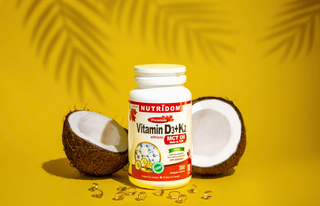Vitamin D3 + K2 with MCT oil
Nowadays most people know that Vitamin D and Vitamin K are key for good health. However, do you know why each of these vitamins is so important for your health? These vitamins can be taken in combination since they are both fat-soluble vitamins, but first lets look at each vitamin separately.
What is Vitamin D?
This fat-soluble vitamin is also often called the ‘sunshine vitamin’. Under the right circumstances our skin is able to synthesize Vitamin D from the UV rays from the sun. This can work well during the summer months, but can make it more challenging to get enough Vitamin D in the winter months. Vitamin D is also not naturally present in a lot of our foods, so either consuming fortified foods or taking a supplement is generally a good idea. There are two main forms of Vitamin D: Vitamin D2 (ergocalciferol) and Vitamin D3 (cholecalciferol). The active form of vitamin D that the body actually uses more quickly is Vitamin D3.
What Does Vitamin D Do?
- Promotes calcium absorption in the gut
- Maintains appropriate calcium and phosphate levels in the blood
- Normal bone mineralization
- Ensures the muscles contract properly
Additional Roles
- Monitor cell growth
- Modulate cell differentiation and death
- Neuromuscular and immune function
- Activation of various genes and their associated proteins
Sources of Vitamin D
Food sources of Vitamin D are not significantly high, and some of the best sources most people do not consume on a regular basis. Sources include:
- Flesh of fatty fish (such as salmon, tuna, and mackerel) and fish liver oils are among the best sources
- Small amounts of vitamin D are found in beef liver, cheese, and egg yolks.
- Vitamin D in these foods is primarily in the form of vitamin D3 and its metabolite 25(OH)D3.
- Some mushrooms provide vitamin D2 in variable amounts
Vitamin D Recommendations
The daily recommendation for vitamin D is currently set at 400 IU for adults and children 4 and over. Food labels are not required to list vitamin D content unless it’s been fortified, which can make it more difficult to estimate consumption from food sources. Foods providing 20% or more of the daily value are considered to be high sources. For people that are deficient, this is generally not enough.
Vitamin D Deficiency
Nutrient deficiencies are usually the result of dietary inadequacy, impaired absorption and use, increased requirement, or increased excretion.
A vitamin D deficiency can occur when:
- Usual intake is lower than recommended levels over time
- Exposure to sunlight is limited
- The kidneys cannot convert 25(OH)D to its active form
- Absorption of vitamin D from the digestive tract is inadequate
- Vitamin D-deficient diets are associated with milk allergy, lactose intolerance, ovo-vegetarianism, and veganism
Groups at Risk of Vitamin D Deficiency:
- Breastfed Infants
- Older Adults
- People with limited sun exposure
- People with darker skin
- People with Inflammatory Bowel issues
- People who are obese or have undergone gastric bypass surgery
What is Vitamin K?
This fat-soluble vitamin comes in two main forms. The main type is called phylloquinone, which can be found in green leafy vegetables like collard greens, kale, and spinach. The other type, menaquinones, are found in some animal foods and fermented foods. Menaquinones are also produced by bacteria in the human body.
What does Vitamin K Do?
Vitamin K helps to make various proteins that are needed for blood clotting and building bone. Prothrombin, is a vitamin K-dependent protein directly involved with blood clotting. Osteocalcin, is another protein that requires vitamin K to produce healthy bone tissue.
Vitamin K is found throughout the body including the liver, brain, heart, pancreas, and bone. Vitamin K is broken down very quickly and excreted in urine or stool. Due to this, vitamin K rarely reaches toxic levels in the body even with high intakes, as may sometimes occur with other fat-soluble vitamins.
Sources of Vitamin K
Phylloquinone
- Green leafy vegetables including collard and turnip greens, kale, spinach, broccoli, brussel sprouts, cabbage, lettuces.
- Soybean and canola oil
- Salad dressings made with soybean or canola oil
- Fortified meal replacement shakes
Menaquinones
- Natto (fermented soybeans)
- Smaller amounts in meat, cheese, eggs
Vitamin K Recommendations:
For vitamin K, there aren’t current recommendations set, or what is called the recommeded dietary alowance (RDA). Therefore, since there isn’t enough evidence to firmly establish RDA, the label of ‘adequate intake’ or AI is what is used. The AI for vitamin K for adults 19 and older is 120 mcg for men and 90 mcg for women.
Vitamin K Deficiency:
Significant vitamin K deficiency in adults is uncommon, but may occur in people taking medications that block vitamin K metabolism such as antibiotics, or in those with conditions that cause malabsorption of food and nutrients. A deficiency is also possible in newborn infants because vitamin K does not cross the placenta, and breast milk contains a low amount. The limited amount of blood clotting proteins at birth increases the risk of bleeding in infants if they are not given vitamin K.
The following are the most common signs of a deficiency:
- A longer time for blood to clot or a prolonged prothrombin time (as measured in a doctor’s office)
- Bleeding
- Hemorrhaging
- Osteopenia or osteoporosis
Vitamin D and Vitamin K are each important on their own, but they also work together. For example they work together to help make sure calcium is deposited correctly in the body. An additional way to make these vitamins easier to absorb is to take them with healthy fat. If supplementing, taking it in a softgel or liquid that is mixed with a good quality oil can make absorption more effective.

